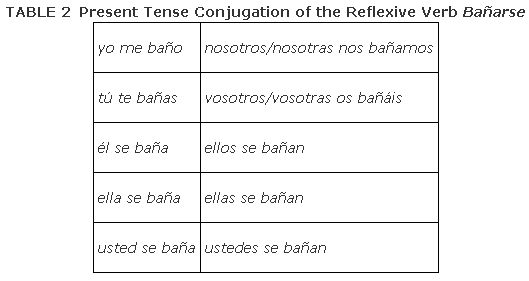A reflexive verb has ‐se attached to the end of its infinitive form and, when conjugated, will use the appropriate reflexive pronoun in front of any conjugated form of the verb. Table 1, demonstrates which reflexive pronoun is appropriate for each subject pronoun.

In Spanish, a reflexive verb always has a reflexive pronoun whether or not the subject pronoun is used. The reflexive pronoun is placed in the sentence in exactly the same way as a direct object pronoun or an indirect object pronoun. If a reflexive pronoun is used in conjunction with a direct object pronoun or an indirect object pronoun, the reflexive pronoun is always first. The order of object pronouns in a sentence is easily remembered with the acronym RID (Reflexive, Indirect, Direct). Although all three pronouns are never used together, whichever object pronouns are in a sentence will follow the order RID.
- Yo me lo prometí que visitaría a Marruecos otra vez.
- I promised it to myself that I would visit Morrocco again.
- Te la pusiste (la falda).
When a reflexive verb is conjugated in any tense, the ‐se is removed from the infinitive form and the appropriate reflexive pronoun is used to reflect the subject of the sentence. Notice in Table that the reflexive pronouns are similar to direct object pronouns and indirect object pronouns, but they are even easier to learn because the third person reflexive pronoun is always se. The blank represents where the conjugated form of the verb goes.
Some verbs are always reflexive, but any verb that can have an indirect object or direct object can be used as a reflexive verb if the object is the same as the subject. The term “reflexive” indicates that the subject of the sentence both causes and receives the action of the verb. For example, the verb bañar means “to bathe something or someone else,” but the reflexive verb bañarse means “to bathe oneself.” A strange quirk of the English language is that reflexives are occasionally stated with an expression using “take.” For example, “she bathes herself” is equivalent to “she takes a bath.” The only way to express this in Spanish is to use the reflexive. Table 2, the conjugation chart for the reflexive verb bañarse, shows which reflexive pronoun goes in front of each conjugated form of the verb.

When the plural subjects have reflexive pronouns, there are actually two possible interpretations. As you learned in the song above, reflexive pronouns can indicate reciprocity. That means that the people represented by the plural subject do the action of the verb to each other. Sometimes, it is obvious that the reflexive pronoun is being used to indicate reciprocity:
- Ellos se casaron el 21 de mayo.
- They married each other on May 21.
Technically, the sentence could be stating that they married themselves, but logic allows us to assume that reciprocity is indicated. The other use of the reflexive can also be assumed in a sentence:
- Nosotros nos bañamos todas las mañanas.
- We take a bath (bathe ourselves) each morning.
It is possible but not probable that we bathe each other. When a reflexive verb has a plural subject, there will be two possible translations, but the context of the sentence should give away the correct interpretation. This problem does not occur when the subject is singular because it is impossible to have reciprocity with only one person.
Some verbs are always reflexive, some verbs have a completely different meaning when they are reflexive, and some are simply used reflexively to indicate that the action of the verb is being done by the subject to the subject. The following lists of the different kinds of reflexive verbs provide a great opportunity to improve your vocabulary as well as your understanding of the different kinds of reflexive verbs.
The verbs in the following list can be used as reflexive verbs to indicate that the action of the verb is being done to oneself. You will notice that it is common in English to use the expression “get” to indicate that something is being done to oneself. For example “to get tired” or “to get dressed” is the same as saying “to tire oneself” or “to dress oneself.”

Many reflexive verbs indicate that one is doing something to one's own body. Because the reflexive pronoun already indicates that the subject of the sentence is doing the action of the verb to him- or herself, it is considered repetitive to use a possessive adjective in front of the body parts in question. Thus, use the appropriate definite article in front of the body part rather than a possessive adjective:
- Yo me peino dos veces al día.
- I comb my hair twice a day.
- Lolita se lava las manos antes de comer.
- Lolita washes her hands before eating.
Linguistically, Spanish speakers take responsibility for their own emotions because many verbs indicating emotions are used reflexively. It is almost as if a person “bores himself” or “angers herself.” The English translations of these kinds of emotion verbs often begin with the expressions “to get” or “to become.” These same verbs can be used without the reflexive pronoun when the action of the verb is being done to someone else.

Many reflexive verbs have only slightly different meanings from their non‐reflexive versions. Sometimes you have to think about it, but they make sense. For example, parar means “to stop” and pararse means “to stand,” which is what happens after you stop yourself.

|
|
|
|
|
|
|
|
|
|
|
|
|
|
|
|
|
|
|
|
|
|
|
|
|
|
|
|
|
|
|
|
|
|
|
|
|
|
|
|
|
|
|
|
|
|
|
|
|
|
|
|
|
|
|
|
|
|
|
|
|
|
|
|
|
|
|
|
|
|